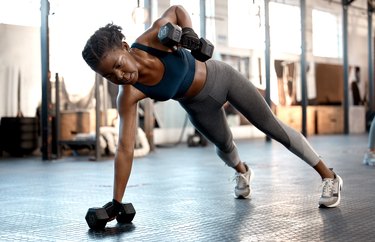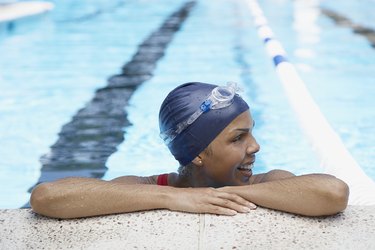
If you have psoriasis, a chronic disease that causes raised skin patches, you may be wondering if high-intensity exercise is safe. After all, sweat is a common irritant, and high-intensity workouts — whether chasing miles on the bike or slinging heavy weights — can leave you drenched.
That said, it doesn't mean you have to avoid high-intensity exercise altogether. There's an association between exercise and a reduced risk of psoriasis flares, according to an August 2012 study in JAMA Dermatology. And with the right psoriasis treatment, it's possible to do vigorous workouts.
Video of the Day
Video of the Day
"We know that psoriasis can flare in the setting of stress — illness, sunburns, skin trauma. High-intensity/high-impact exercise in this context can possibly flare psoriasis," Harry Dao, MD, a dermatologist at Loma Linda University Health, says. "However, an important point to make is that optimal treatment of psoriasis can decrease baseline disease activity, and potentially even mitigate psoriasis flares from these triggers."
Other than consulting your healthcare provider about the proper course of psoriasis treatment for you, there are some other steps you can take to ensure you stay comfortable during your workouts and aren't making skin irritation worse.
4 Tips for High-Intensity Exercise With Psoriasis
1. Avoid High-Intensity Exercise During a Flare
If you're currently experiencing a flare, it's best to avoid high-intensity exercise until your symptoms ease up. The sweat, friction and heat can cause more skin irritation, Dr. Dao says.
"While it's not required to take a break from high-intensity exercise when experiencing a psoriasis flare, if you are uncomfortable, then choose low-to-moderate-impact exercise, even options such as water-based activities like swimming," Kellie Reed, MD, a board-certified dermatologist at Westlake Dermatology in Austin, Texas, explains. "Chafing around the groin, breasts or abdomen can also cause plaques to develop in these areas."
Signs that you should scale back on the intensity are redness of the skin, fissures (linear sores in the skin), skin tears and skin pain. If you also notice that your symptoms are improving without high-intensity exercise but get worse with it, you should probably hold off, Dr. Dao says.
Doing low-impact or low-intensity exercises, like walking and taking a leisurely bike ride, can help you stay active without aggravating your symptoms, Anna Chacon, MD, a board-certified dermatologist based in Miami, Florida, says.
It's important to know your limits, so if you have an understanding of where your threshold for stress and skin irritation are, stop there. Doing a cooldown post-workout can also help bring down your heart rate and reduce sweating, Dr. Reed suggests.
"With optimal psoriasis treatment on board, the hope is that you can have close to a 'normal' life as possible, and that includes being able to engage in high-intensity exercise with as little fear of flaring your psoriasis as possible," Dr. Dao says.
And even if you can't do sweaty runs during a flare-up, you don't want to avoid exercise altogether: "Psoriasis is linked to higher risks of cardiovascular morbidity and mortality, for example from heart attacks and strokes," Dr. Dao says. "Routine exercise, combined with a heart-healthy diet, can decrease these risks."
2. Talk to Your Doctor About Sweat-Controlling Treatments
While there's not much you can do to prevent sweat, there are ways you can help keep it from causing skin irritation.
For example, "absorbent powders applied to areas of excessive sweat, such as the folds of the skin, can help decrease excessive moisture build-up," Dr. Dao says. Other potential treatments can also help ease any discomfort that may arise ahead of time.
"Seeing your board-certified dermatologist to discuss other potential prescription treatments to decrease sweat or procedures/devices that can decrease sweat response, such as iontophoresis, can open other options to consider," Dr. Dao says. Botox can also be used.
Iontophoresis is a type of skin treatment that involves passing a weak electrical current through the skin, according to the U.S. Library of Medicine. Iontophoresis reduces sweating by blocking sweat glands. It is used to help treat hyperhidrosis, which is a condition that causes excessive sweating.
And you should also always wear fresh, dry exercise clothes. Sorry, but there's no re-wearing workout leggings, even if you didn't sweat much when you wore it.
"Inflammation can be brought on by dried sweat, grime and other material. For regions that are prone to irritation, use petroleum jelly, an anti-chafing lotion or an anti-chafing stick to avoid chafing," Dr. Chacon says.
3. Wear Breathable, Sweat-Wicking Workout Clothes
Speaking of clothing, you can help control moisture by suiting up appropriately for your workouts, Dr. Dao says. Clothing made of sweat-wicking and quick-drying materials, such as polyester, nylon, bamboo and spandex, is better than those with an absorbent and slow-drying fabric like cotton.
"During physical activity, wearing tight clothing can irritate the skin and exacerbate psoriasis patches. It is easier to remove sweat and allow it to evaporate quickly when wearing loose, breathing clothing and materials," Dr. Chacon says.
If you're someone who heats up fast, you may want to choose workout clothing that has some ventilation. Many workout leggings, shorts, shirts and tanks have mesh panels that give you a bit of breathing room.
And because you're doing hard work, don't forget to hydrate before, during and after your workout. "Replacing lost fluids with enough hydration is important to keep the skin moisturized and prevent flare-ups," Dr. Chacon says.
4. Apply Sunscreen, But Skip Other Topicals
Sunscreen protection is a must for everyone, but especially for those with psoriasis. Phototherapy is a legitimate therapy for psoriasis, but is done in a clinical setting, carefully monitored and dosed. Natural UV exposure is impossible to measure or dose accurately to follow via any regimented treatment protocol, according to Dr. Dao.
"UV protection to help decrease photoaging, photodamage and long-term skin cancer risk is helpful even if you have psoriasis," Dr. Dao says. "When engaging in sweat-inducing activity, water-resistant sunscreens can be helpful as long as you are not allergic to the ingredients."
If you're exercising outdoors, applying sunscreen can help prevent sunburn and skin irritation. Remember to reapply every two hours.
However, you want to avoid using topical steroids immediately before a workout. They're often in ointment form, which can be occlusive, trapping your sweat and potentially causing more irritation. Best to apply right after a shower.
Can You Do High-Intensity Exercise While Taking Biologic Medications?
Know your limits before engaging in high-intensity exercise and discuss your concerns with your doctor before you start a new workout routine. But generally speaking, biologic treatment shouldn't decrease your exercise tolerance, Dr. Dao explains.
"In actuality, it should increase exercise tolerance by decreasing any concomitant issues with psoriatic arthritis (less joint pain, stiffness, swelling) and by decreasing psoriasis involvement of the skin," he says.
That's because biologics work by stopping the physiological mechanisms that cause psoriasis and the associated symptoms, Dr. Chacon says. So if you have psoriatic arthritis, for instance, a biologic can reduce pain, stiffness and edema in your joints and help prevent further joint damage.
"You should consult your doctor first, of course. Work up to a more advanced level of fitness starting with something simple like walking, which combines strength, endurance and flexibility. Once it gets comfortable, you can increase the intensity to gauge how your body will react," Dr. Chacon says.
As long as you don't have any damage in your weight-bearing joints, high-intensity exercise that are higher impact, like running or jogging, should be fine. Similarly, if you have joint damage or pain in your upper extremities, you should avoid exercises that may put extra pressure on them, such as boxing or heavy weightlifting, Dr. Chacon says.
Was this article helpful?
150 Characters Max
0/150
Thank you for sharing!
Thank you for your feedback!


